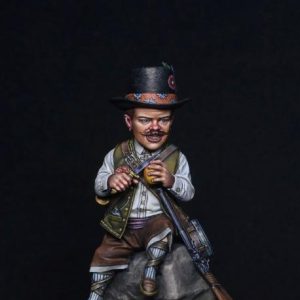Descrição
Despite the rise of knightly cavalry in the 11th century, infantry played an important role throughout the Middle Ages on both the battlefield and in sieges. From the 14th century onwards, there was a rise in the prominence of infantry forces, sometimes referred to as an “infantry revolution“. In the medieval period, the mounted warrior held sway for an extended time. Typically heavily armoured, well-motivated and mounted on powerful, specially bred horses, the mounted knight represented a formidable force, which was used to effect against more lightly armoured troops. Since only the noble classes could afford the expense of knightly warfare, the supremacy of the mounted cavalryman was associated with the hierarchical structure of medieval times, particularly feudalism. As the period progressed, however, the dominance of the cavalry elite began to slowly break down. The Black Death in the 14th century swept through Europe, devastating the population, and resulting in serious manpower shortages. This encouraged more economical use of available manpower, and the infantryman was much cheaper to outfit and maintain than the aristocratic knight. The Crusade era also saw a rise in the importance of infantry and required large numbers of men and material to be organized for distant battlefields. Such expeditions were part of the growing number of sieges, disputes and campaigns throughout the 13th and 14th centuries that greatly increased the cost of warfare for medieval regimes. The relative inexpensiveness of the infantryman, combined with a shortage of manpower, provided incentives for expanding their use.
By the 11th century, much of the infantry fighting was conducted by high-ranking nobles, middle-class freemen and peasants, who were expected to have a certain standard of equipment, often including helmet, spear, shield and secondary weapons in the form of an axe, long knife or sword. Peasants were also used for the role of archers and skirmishers, providing missile cover for the heavy infantry and cavalry. The later Medieval period also saw the expansion of mercenary forces, unbound to any medieval lord. The Swiss Pikeman, the German Landsknecht and the Italian Condottiere are three of the best known examples of this new class of fighting man. The expanded campaigns, castle-building and sieges of the era also saw greater use of household troops, often bodyguards of the elite, with a variety of useful skills. These were cheaper to recruit and maintain than knights, with all their trappings. Siege warfare required large bodies of troops in the field, for extended periods, including numerous specialists. All this added up to make the early days of peasant levies unsustainable. As more kings and lords turned to infantry, their opponents had to keep pace, leading to additional increases in foot troops. To obtain the best fighting men, elites had to make provision for their regular payment and supply.
The rising importance of foot troops, thus, brought not only the opportunity but also the need to expand armies substantially. Thus, as early as the late 13th century, we can observe Edward I campaigning at the head of armies incorporating tens of thousands of paid archers and spearmen. This represented a major change in approaches to recruitment, organization, and above all pay. There are three components to the so-called “military revolution” occurring at the end of the Middle Ages. According to Christine de Pizan, there are two great evils …. A disordered formation, where the enemies can easily break into it and the other is the compression of the formations and they cannot fight. Thus, it is important to keep the formation in ranks and tight and joined together like a wall.
Militia forces were often organized by guilds or districts, with their officers and banners. Swiss muster rolls show officers and standard bearers being appointed, and men being assigned to positions in the formation. Various accounts show that it was the role of commanders to make sure their men knew their position in the formation, knew which banners they fought under and who stood around them.
We can see the importance of infantry to the detriment of heavy cavalry, increasing use of gunpowder weapons on the battlefield and sieges, as well as social, political, and fiscal changes allowing the growth of larger armies. The first of these components to manifest itself as the “infantry revolution“, which developed during the 14th century. Initial victories like Courtrai or Morgarten were strongly dependent on use of terrain but over the course of the century two effective infantry systems developed; the infantry block, armed with spears and polearms, epitomised by the Swiss and the practice of combining dismounted men-at-arms with infantry with ranged weapons, typified by the English longbowman.
It would be wrong to assume that the infantry revolution swept heavy cavalry from the field. Improvements in armour for man and horse allowed cavalry to retain an important role into the 16th century. Instead, the three components of revolution identified by Ayton and Price led to a rebalancing of the elements of the medieval tactical system, opening the way for an integrated arms approach in the 16th century.















Avaliações
Ainda não existem avaliações.